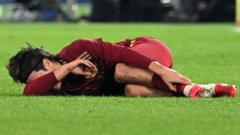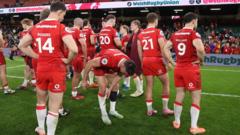Can a Manager Change Cause More Injuries?

Published: 2025-11-10 11:00:30 | Category: sport
The recent Uefa study has revealed a concerning trend: new football managers bringing their own fitness or performance coaches to clubs can lead to a threefold increase in hamstring injuries. This spike in injuries often stems from players pushing themselves harder to impress new management, coupled with shifts in training regimens that may not align with the athletes' previous conditioning. Understanding these factors can help clubs mitigate injury risks during transitional periods.
Last updated: 18 October 2023 (BST)
What’s happening now
As the football season progresses, the implications of managerial changes on player health have come under scrutiny. The Uefa study indicates that clubs may need to reconsider their onboarding processes for new managers and their accompanying staff. This study highlights the urgent need for clubs to balance the implementation of new training philosophies with the existing fitness levels of players to prevent injury.
Key takeaways
- New managers can lead to a significant increase in player injuries, particularly hamstring injuries.
- Players may push through minor injuries to impress, leading to longer-term issues.
- Changes in training intensity and focus can disrupt players’ conditioning.
Timeline: how we got here
The trend of increased injuries following managerial changes has been documented over several years. Key milestones include:
- 2015: Jurgen Klopp joins Liverpool, resulting in over 20 injuries in three months.
- 2020: A study of Turkish Super League clubs indicates injury rates more than double after managerial changes.
- 2023: Uefa publishes findings showing new managers significantly raise hamstring injury risks.
What’s new vs what’s known
New today/this week
The recent Uefa study adds quantitative data to longstanding anecdotal evidence about injury spikes when new managerial staff are introduced. The threefold increase in hamstring injuries following such changes is particularly alarming and calls for immediate attention from club management.
What was already established
It has been well-documented that a new manager can disrupt established training routines, leading to increased injuries. Experts in sports physiotherapy and injury prevention have long cautioned about the risks of overexertion and improper training adjustments.
Impact for the UK
Consumers and households
The increase in player injuries can have a ripple effect on fans and families, impacting matchday experiences and overall club performance. Households invested in local clubs may feel the repercussions of poor team performance due to player unavailability.
Businesses and jobs
For clubs, the implications extend to financial performance and job security for managerial staff. High injury rates can lead to poor results, prompting further managerial changes and instability within the club structure.
Policy and regulation
Clubs may need to adopt stricter guidelines when hiring new staff, particularly in how they integrate training philosophies. This could involve mandatory assessments of player fitness before implementing new regimes to avoid unnecessary injuries.
Numbers that matter
- Threefold increase in hamstring injuries noted in Uefa's study when new coaching staff arrive.
- More than 20 separate injuries reported at Liverpool under Klopp during his initial months.
- Injuries doubled within the first two weeks of coaching changes in Turkish Super League clubs.
Definitions and jargon buster
- Hamstring injuries: Injuries affecting the group of muscles located at the back of the thigh, often resulting from overstretching or sudden movements.
- GPS data: Technology used to monitor player performance metrics, including speed and distance during training and matches.
How to think about the next steps
Near term (0–4 weeks)
Clubs should focus on closely monitoring player fitness levels and gradually introducing any new training regimens. This involves assessing current fitness and injury history before implementing changes.
Medium term (1–6 months)
Establishing a consistent training schedule that allows for gradual adaptation to new methods will be crucial. Clubs may also consider investing in injury prevention programmes tailored to their players' needs.
Signals to watch
- Injury reports, particularly focusing on hamstring issues.
- Changes in training intensity as new management settles in.
- Player feedback regarding training methods and personal fitness levels.
Practical guidance
Do
- Assess players' fitness levels before introducing new training methods.
- Monitor GPS data to maintain appropriate training loads.
- Maintain open communication with players regarding their physical well-being.
Don’t
- Don’t rush to implement new training regimes without assessing player readiness.
- Don’t ignore players’ reports of discomfort or minor injuries.
- Don’t overlook the importance of recovery time between training sessions.
Checklist
- Evaluate players' past injuries and fitness levels.
- Establish a baseline for training intensity.
- Monitor players' responses to training changes.
- Adjust training loads based on individual player feedback.
- Incorporate regular recovery sessions into the training schedule.
Risks, caveats, and uncertainties
While the correlation between new managerial appointments and injury rates is established, the extent of this impact can vary significantly between clubs based on their unique circumstances. Factors such as the league's intensity, player conditions, and existing training regimens all play crucial roles. Clubs must exercise caution in drawing conclusions from injury data, as it can be influenced by external variables, including fixture congestion and player fatigue.
Bottom line
The findings from Uefa's study highlight a pressing issue in football: the need for careful management of training transitions when new coaches arrive. Clubs must strike a balance between implementing new strategies and maintaining player health to avoid a spike in injuries that could derail their season.
FAQs
Why do injuries increase when a new manager arrives?
Injuries often increase due to players pushing themselves harder to impress, combined with changes in training that may not suit their conditioning.
What types of injuries are most common during this period?
Hamstring injuries are particularly prevalent, as indicated by the recent Uefa study.
How can clubs mitigate these injury risks?
Clubs should assess players' fitness levels and gradually introduce new training methods to avoid overwhelming them.



